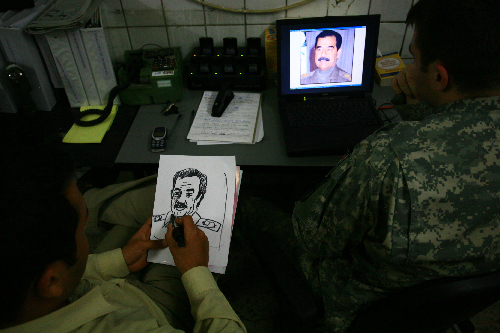BASE WORLD, Iraq — The spring of 2006 in Iraq started with the February bombing of Samarra’s revered Shiite Golden Dome Mosque, which triggered a massive escalation of Sunni-Shiite violence and the descent into inter-communal strife. It was a violent season and the period when Iraq’s politicians came face-to-face with the reality that their country was mired in civil war.
That spring, I visited Iraq and embedded with the U.S. Army, spending several days roaming the U.S. bases scattered across the length and breadth of that land. Despite the violent turmoil ripping apart the country, very little violence penetrated beyond the perimeter fencing and the vigilant human and electronic guards surrounding the military camps. A defused roadside bomb here, there a stray mortar crashing harmlessly into the vast storage areas that make up so much of the acreage of every base. Incidents that barely merited mention for the vast majority of base-bound personnel who rarely emerge from the padded, warped reality of their country’s 21st century Iraqi occupation.
Cocooned from the danger outside and starved for subject-matter, I roamed the bases I found myself transiting through, photographing the everyday life of the American soldiers that inhabit them: the churches, metal cabins housing the troops, makeshift gyms, elaborate retail villages catering to consumer instincts galvanized by another day survived, or target ranges pulsating with the thud of molten lead spouting from sizzling guns.
Some camps were basic Forward Operating Bases dancing a waltz of death with an insurgency forever lurking on their edges. Others were miniature suburban towns bristling with freshly mown lawns, all-American congregations singing hymns inside chapels that were the sturdiest civilian buildings on base, shops selling SUVs and advertising stateside delivery, soldiers whiling away their off-time in the extensively stocked cafeterias, Third World workers inhabiting a parallel security system that saw them trucked from their camps to their places of work and back again . . .
I entered this incestuous military system with an American soldier motioning for me to stand up against an exposed white wall and giving me a full-body radiation scan — “Kiss the family goodbye, buddy!” was his cheerful refrain — and left it one April morning two weeks later as I drove out of the Green Zone, past the concentric circles of first American, then Latin American and finally Iraqi guards, into the Red Zone, a place where death comes often and recurringly, striking with morbid repetition in the mosques, markets and neighborhoods where humanity congregates to practice the rituals of a life inhabited in the margins of imminent annihilation.










Iason Athanasiadis is an analyst, writer and photographer.
